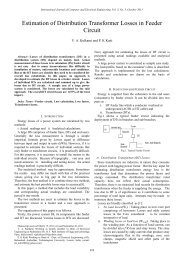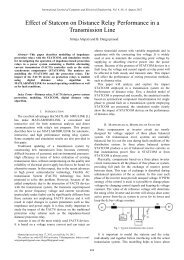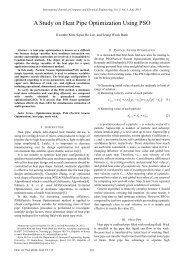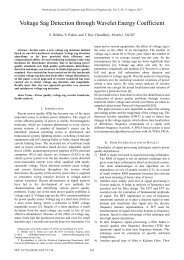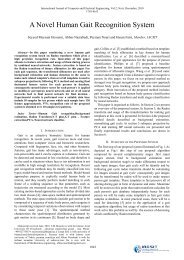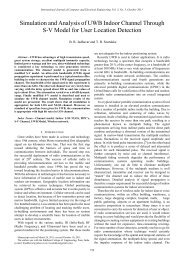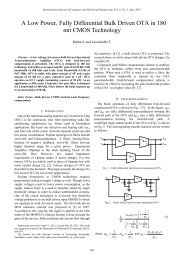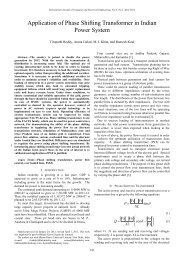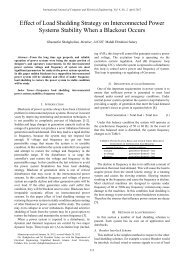3D Cranio-Facial Surface Modeling from 2D CT Slices Using ... - ijcee
3D Cranio-Facial Surface Modeling from 2D CT Slices Using ... - ijcee
3D Cranio-Facial Surface Modeling from 2D CT Slices Using ... - ijcee
Create successful ePaper yourself
Turn your PDF publications into a flip-book with our unique Google optimized e-Paper software.
International Journal of Computer and Electrical Engineering, Vol. 2, No. 5, October, 2010<br />
1793-8163<br />
this format contains information about the slice angle, depth<br />
etc. Normally the thickness of the slice will be .75 mm.<br />
Fig 1. DICOM Image<br />
with a pixel spacing of [2 X 1 double] and with a height and<br />
width of 512 X 512. DICOM format can differentiate up to 1024<br />
gray levels whereas TIFF format can differentiate up to 256<br />
levels proposed system is intended to have low memory<br />
requirements. Hence slices are converted <strong>from</strong> DICOM format<br />
to TIFF format, without losing the structural information.<br />
B. System Description<br />
The functional modules of the system have two phases<br />
namely pre-processing and reconstruction. Pre-processing<br />
involves bilateral filtering and further processing includes<br />
Slice Thresholding, ROI processing, FAST corner detection<br />
and Point cloud generation.<br />
<strong>Surface</strong> reconstruction is performed through Delaunay<br />
triangulation. Fig 2 depicts the System architecture of the<br />
system<br />
C. Pre-processing<br />
Pre-processing is carried out to suppress unwanted<br />
distortions or enhances some image features important for<br />
further processing. Bilateral Filtering is applied to remove<br />
unwanted noise and distortions.<br />
D. Bilateral Filtering:<br />
A bilateral filter is an edge-preserving smoothing filter. It<br />
replaces a pixel's value by a weighted average of its neighbors<br />
in both space and range (pixel value). This preserves sharp<br />
edges by systematically excluding pixels across<br />
discontinuities <strong>from</strong> consideration. For the central pixel of the<br />
neighborhood ao, its new value, denoted by,<br />
Fig 3. Bilateral Filtered Image<br />
where „g‟ is the domain filter and ‘r’ is the range filter, ‘k‟ being<br />
the normalization constant. Bilateral filtered image is shown in<br />
Fig 3.<br />
E. Region of Interest (ROI) Processing<br />
ROI returns a region of interest within an indexed or<br />
intensity image and returns a binary image. Threshold required<br />
for ROI processing is determined by global thresholding of <strong>CT</strong><br />
slice.<br />
Global Threshold:<br />
Global threshold is computed by determining the average<br />
value of the maximum and the minimum pixel value of the <strong>CT</strong><br />
slices. Threshold range used is tabulated in Table 1.<br />
TABLE 1. THRESHOLD RANGE<br />
SLICE NO<br />
THRESHO LD RANGE<br />
1-215 0.4-0.5<br />
216-236 0.3-0.4<br />
ROI processing is carried out for each <strong>CT</strong> slice and the result<br />
of this process is shown in Fig 4.<br />
F. FAST Corner Detection<br />
The feature detector considers pixels in a Bresenham<br />
circle of radius r around the candidate point. If n contiguous<br />
pixels are all brighter than the nucleus by at least threshold<br />
„t‟ or all darker than the nucleus by „t‟, then the pixel under the<br />
nucleus is considered to be a feature.<br />
FAST corner detector operates in two stages. It begins by<br />
using the segment test criterion for „n‟ number of pixels and a<br />
convenient threshold.<br />
... ( 1 )<br />
Fig 4. ROI processed image<br />
Fig 2. System Architecture<br />
932<br />
Let P be the set of all pixels in the test image. P is partitioned<br />
into three subsets Pd (darker), Ps (similar), Pb (Brighter). Every<br />
center pixel is compared with the set of contiguous pixels<br />
around it. If all the contiguous pixels are all either darker or<br />
brighter when compared to the center pixel, then the pixel<br />
under consideration can be defined as a corner point.<br />
FAST Corner Detector is computationally efficient and<br />
provides stable features. It has high detection rate and the



